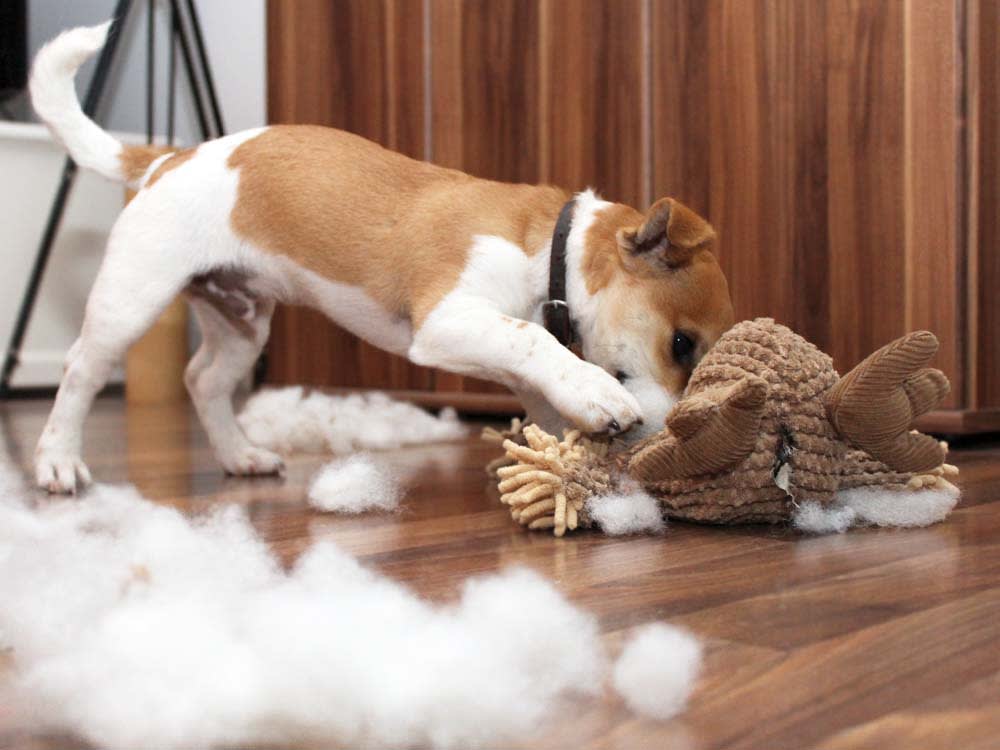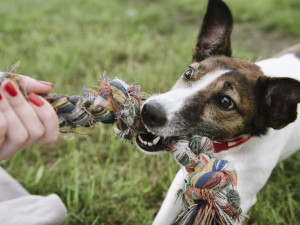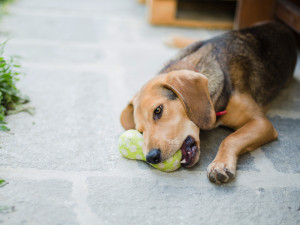5 Ways to Stop Your Dog From Ripping Up Their Toys
How to teach your dog to enjoy, not destroy, their toys.

share article

Your pet wants you to read our newsletter. (Then give them a treat.)
Nobody likes spending upwards of $20 on a dog toy only to have the shark-disguised-as-a-dog who shares your life obliterate it in two minutes and 38 seconds flat (give or take). No matter how happy the dog is, it’s not budget-friendly to spend that kind of money for such a brief period of recreation. That’s why I like teaching dogs to enjoy their toys without destroying them. That may seem an impossible task, but it can be done, and here’s how.
1. Teach them how to play with the toy
Engage your dog in play with the toy. Play fetch, tugopens in a new tab, or hide-and-seekopens in a new tab with the toy, or drag it along the floor for your dog to pounce on it. If your dog has fun playing a game with you that involves the toy, they will understand the purpose of the toy. While your dog is still learning the toy is part of a game, put it away when you are done playing. Once they know what the toy is for, they will want to play the game rather than chew and shred the toy. Until they know better, don’t let them make a mistake and destroy it.
2. Take toys away strategically
Don’t set a dog up to fail by leaving them with an errant toy to ruin by chewing it up. Offer the dog the toy, but if they start to shred it, take it away, whether they are picking at it with their teeth or chomping on it with serious biting. Give it right back so they can try again to treat it gently. If they are careful with the toy, let them keep it and offer attention, praise, or play in response to their behavior. Continue to supervise, watching constantly so if they go into destroyer mode, you can immediately take it away.
You are teaching your dog that destructive chewing of the toy makes it disappear. If your dog tries three times to destroy the toy, it’s gone for the rest of the day. Some dogs learn to be gentle in just three repetitions, but others require multiple days of this to stop chewing on toys meant for play.
3. Offer chew toys to satisfy that need
Dogs need to chew — some more than others. They should be allowed to engage in this natural activity, but only with appropriate items. Your veterinarian has the final word on which toys are safeopens in a new tab for your particular dog, but Chewstix and Nylabones are usually excellent choices, while rawhide is potentially hazardous. Some dogs do great with real bones, cow hooves, antlers, and pig ears, but others risk injury from sharp pieces or splinters.
4. Make tired time fleece time
Many dogs find comfort in soft, cuddly, fleece toys. However, they are oh so easy to chew to pieces, which is why most dogs must be taught to snuggle with fleece toys instead of eating them. When your dog is especially tired from a long play session or an extended hike, offer them a fleece toy, as they are most likely to treat it like a teddy bear in this state. If they start to chew on it, take it away, but let them keep it as long as they act tenderly toward it.
5. Offer multiple toys
Giving a dog several identical toys can decrease destructive chewing. Give them one toy, and as soon as they become interested in it, offer them a second one, and when they are into that one, toss a third one their way, and maybe even a fourth. This method prevent many dogs from shredding the toys, perhaps by lowering the value of the toys in their eyes.
Enjoy, don’t destroy
Many people spend a fortune on toys because their dogs destroy them immediately, and others have stopped giving their dogs toys because “it’s a waste — they chew them up in less than five minutes!” You can avoid being in either category by teaching your dog to enjoy — rather than destroy — their toys.

Karen B. London, PhD, CAAB, CPDT-KA
Karen B. London, Ph.D., is a Certified Applied Animal Behaviorist and Certified Professional Dog Trainer who specializes in working with dogs with serious behavioral issues, including aggression, and has also trained other animals including cats, birds, snakes, and insects. She writes the animal column for the Arizona Daily Sun and is an Adjunct Professor in the Department of Biological Sciences at Northern Arizona University. She is the author of six books about training and behavior, including her most recent, Treat Everyone Like a Dog: How a Dog Trainer’s World View Can Improve Your Lifeopens in a new tab.

